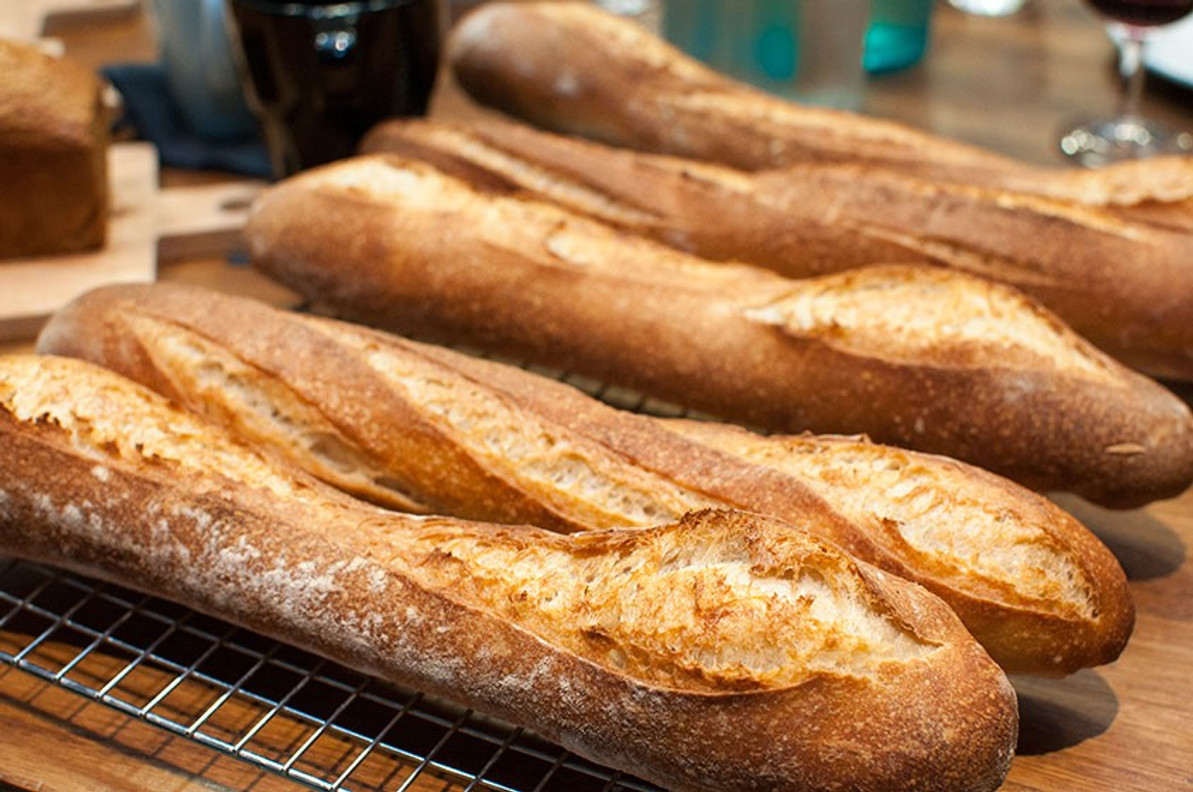Origin Story: The Baguette!
We find origin stories fascinating. And, while dreaming about the perfect baguette sandwich recently, we decided we had to know how this delicious bread came about. But first a bit about the baguette itself...
What is a baguette?
Baguettes are thin, long-shaped loaves of bread that have a crisp, sometimes referred to as “shattering”, outer crust. Like most of the tastiest foods, its ingredients are simple: flour (typically T65 because higher protein = more elasticity), water, salt and a starter like yeast or a “poolish” (a pre-ferment or “old dough” of equal parts flour, water and a bit of yeast). We won’t argue here which results in the better baguette, but poolish advocates tout a nutty, more complex flavor with a crispier crust and tender interior. A three-day process of fermenting, mixing, kneading/folding, rising and baking is the key to producing the characteristic flavor and texture of a truly great French baguette.
What’s the proper way to eat a baguette?
You’ll see many enjoying the crunchy “quignon” or “croûton” (the rounded end of the baguette that peeks out of its paper bag) on the way home from the store. Whether on the way home or when ready to eat it, the tradition is to simply start with twisting off the croûton! When enjoying at home, baguettes are rarely cut on a cutting board. Instead, the thin, crispy crust allows for the loaves to be cut ‘in the air’ or pieces are torn off by hand. In a restaurant, though, you will find baguettes served cut in slices in a breadbasket.
Why do baguettes get so hard so quickly?
An age-old question – and the answer is starch retrogradation. It’s a natural staling process where the starch cells in the bread crystallize, pushing water out of the soft interior called the “crumb”. The baguette’s airy dough is absent of fats, dairy and sugars that typically help trap moisture and slow down the process of starch retrogradation in other breads. The baguette's larger surface area to volume ratio and higher water content also lends to the quicker staling process. The small size and thin crust allow moisture to escape more quickly. So, plan to eat your baguettes the same day they are baked/bought to savor the intended taste and texture (a max. of 12-18 hours after it has been baked).
Now for the origin story. Or, in the case of the baguette, stories, since experts don’t agree. Three main origin stories have been put forward over the years and all appear very practical, rather than inspired by taste:
Austrian-Inspired
In 1839, Augus Zang (an Austrian military officer turned baker) brought the first steam oven from Vienna to Paris. He opened the bakery “Boulangerie Viennoise” and introduced, among other bakery items, the croissant and a long, oval-shaped bread from Vienna called Pain Viennois. The Pain Viennois took less time to rise and bake than the traditional large French round loaf called Pain de campagne, nicknamed la Miche. This quicker bake time was important because a French law was passed in the 1920’s that prohibited baking before 4am to reduce noise in neighborhoods. This new law didn’t allow enough prep and bake time for la Miche loaves, increasing the popularity of the Pain Viennois. French sources cite Augus Zang as originating the baguette as part of his work at the Boulangerie Viennoise.
Military-Inspired
One origin story credits Napoleon Bonaparte. It is said that, circa 1805, Napolean ordered his own baker (or local bakers depending on the source) to create a bread loaf that was easier for his soldiers to carry during their marches. Whether the longer, narrower shape was Napolean’s idea or the bakers’ isn’t definitive, but the result was the baguette. Its rod-like, less bulky shape could be attached to the back of the soldiers’ jackets for easy transport.
Peace-Inspired
In November of 1898, the construction of the Paris Metro (subway) system had begun. This enormous project included French workers from various backgrounds and migrant laborers from neighboring countries and colonies. This was characterized as a rough crowd, and working long hours in tight and dark spaces often led to disagreements and fights. These workers were required to bring their own lunch, which was very often large loaves of bread that were tough and required knives to cut. Workers carrying knives worsened the violence on the job site and, according to records, lead engineer Fulgence Bienvenüe asked bakers for bread that could easily be torn apart by hand. As a result, the baguette was created – removing the need for knives and enabling them to be banned on the work site.
We’ll let you decide which origin story seems most plausible!
Union Jack Tool’s Food Safety Products
Baking has a long history and has come a long way in how commercially-baked products are produced. We carry food safe material handling and cleaning tools to help bakeries meet today's FDA food processing requirements. Here are some best-sellers from Vikan:
3" Pastry / Detail Brush with Soft Bristles

1.5" Stainless Steel Hand Scraper

5.7" Stainless Steel Dough Cutter / Scraper

Baker's Bench Brush with Medium Bristles

4" Nylon Scraper with 33" Aluminum Handle

11" Fine-Particle Counter Brush

Floor & Wall Cleaning Pad Holder Kit

Visit the Food Processing section of our store to browse all product categories, including our Metal Detectable products.
Citations:
https://cooknwithclass.com/origin-of-baguettes/
Recent Posts
-
Origin Story: The Baguette!
We find origin stories fascinating. And, while dreaming about the perfect baguette sandwich recently …Sep 16, 2025 -
Stress-Free Freight Deliveries with Union Jack
Let's face it -- ordering anything that ships via freight can be super challenging and frustrating. …Aug 14, 2025 -
Preventing Listeria in your Brewery or Food Processing Drainage System
It is estimated that 30% of drains in food and beverage production facilities test positive for List …Jul 23, 2025




